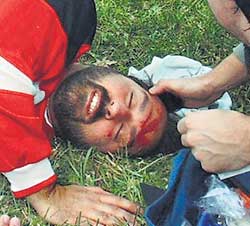
Meeting head injuries head onSome years ago, a cricketer died due to a head injury during a match. More recently, we heard of a popular singer sustaining major head injury in a road traffic accident and having to undergo emergency neurosurgery. Such incidents are increasingly common in Sri Lanka, where trauma is a leading cause of hospitalization; head injury is the main factor that draws the line between life and death.
Head injuries are common, particularly in road traffic accidents, falls, recreational activities and assaults. It is especially common among children and the elderly because they are more prone to falls and accidents. The majority of victims of road traffic accidents, however, are the youth who contribute to the workforce of the country. Head injuries could be minor and negligible, but also life-threatening. The most vital aspect then becomes how such injuries are treated. With proper management within the initial 24 hours, some patients with head injuries could be restored to absolute normality from what appears to be 'almost death'. Therefore identifying the patients who need hospitalization and further evaluation by a doctor is the most crucial decision made at the initial stage, and it is your decision which could make the difference between life and death. Sinister signs If the patient has any of the following signs or was under the influence of alcohol, take him/her to the nearest hospital immediately. The presence of one of the features listed below, does not necessarily mean that the patient's condition is critical, but that it needs observation and medical attention.
If the head injury is minor, meaning there are none of the above symptoms or there is no visible bleeding, first aid at home would be sufficient. Still you would need to keep an eye on the patient, especially in the case of the elderly or children, whose clinical features like drowsiness are difficult to interpret.
Following minor head injury, bruises appear on the head when you have bleeding under the scalp. Called "goose eggs", these would settle spontaneously, taking their time. There is nothing to be alarmed about. Keeping ice would reduce the size of the swelling. Ice has to be applied within the first 24 hours to obtain any benefit. Do not apply ice directly to the skin. It should be applied for 20-30 minutes at a time and can be repeated about every 2-4 hours as needed. Use a light washcloth as a barrier and wrap the ice in it. If there is mild headache, paracetamol can be given in the usual dosage but remember do not give any other medication without advice from a doctor. The child or a person with a minor head injury need not be kept awake to be observed. A child usually goes to sleep after crying for a while. However, you can wake the person from time to time and ask a few questions to check his orientation, for instance "where are you now?" In children, the slightest suspicion should alert you to seek medical advice. If there is a serious head injury or bleeding from the scalp, the patient needs to be taken to hospital. However, in that instance you need to know first aid and how to transport the patient. Do's
Don'ts
Even when there are no visible injuries on the head there could be internal injuries. Bleeding could occur within the skull. If a person loses consciousness particularly for more than one minute after head injury there could be internal injuries. Even if he recovers after a short while, he needs hospitalization for monitoring. In the condition called 'extra dural haemorrhage' or EDH, where there is bleeding between the skull bone and the outermost layer of the brain, the blood vessels there are torn so that there is continuous bleeding inside the skull. When blood gets collected within the skull, the pressure rises pushing the brain downwards. This compressing effect on the brain makes the patient's condition to deteriorate after few hours. So if there is loss of consciousness suggesting that significant force has been applied to the brain at the time of the injury, the chances are that there could be internal bleeding. The patient may need a CT scan and 24 hours observation in hospital.
When the condition is confirmed through the CT scan, immediate surgery has to be done to evacuate the blood clot formed inside the brain. However, when the brain itself is injured and bleeding into brain substance occurs, usually the management is non surgical, where the patient is monitored, given drugs to reduce the swelling inside and nursed till he recovers. In this type of serious injury, the outcome is not as good as in the above. Even after recovering from a serious brain injury, complications can last for a long time. These could manifest as memory loss, personality changes, fits occurring from time to time, change in mental abilities, speech and language problems, loss of sensation, hearing, vision, taste, or smell and paralysis. Therefore if you have had a serious head injury, remember to tell your doctor about it when you are seeking advice for any other condition, which might be related. It would point to a diagnosis and narrow down the list of investigations that you would otherwise need to undergo. Prevention Prevention is the key. Thus, always try to prevent accidents, falls and possible trauma.
|
|
||||||
|| Front
Page | News | Editorial | Columns | Sports | Plus | Financial
Times | International | Mirror | TV
Times | Funday
Times | Medi Scene || |
| |
Reproduction of articles permitted when used without any alterations to contents and a link to the source page.
|
© Copyright
2008 | Wijeya
Newspapers Ltd.Colombo. Sri Lanka. All Rights Reserved. |


